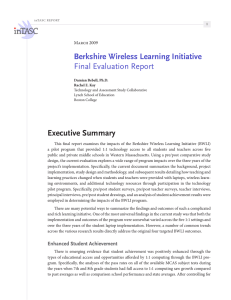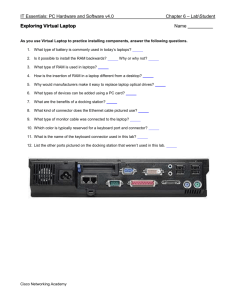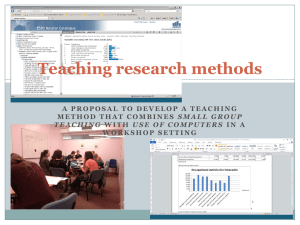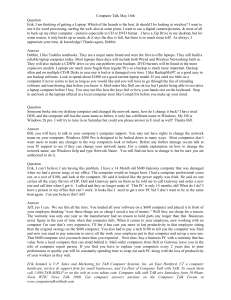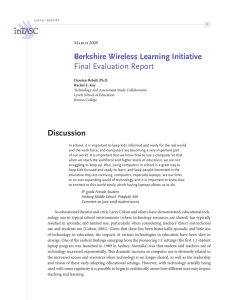Results Berkshire Wireless Learning Initiative Final Evaluation Report Classroom Observation Results: Summary
advertisement
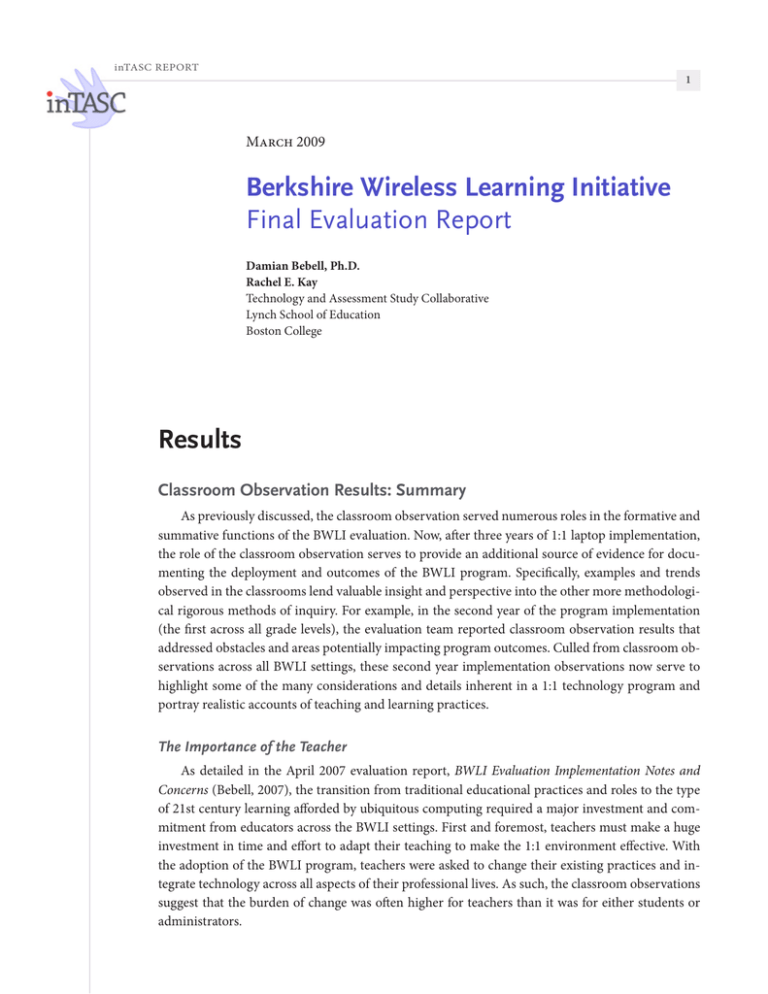
inTASC REPORT 1 March 2009 Berkshire Wireless Learning Initiative Final Evaluation Report Damian Bebell, Ph.D. Rachel E. Kay Technology and Assessment Study Collaborative Lynch School of Education Boston College Results Classroom Observation Results: Summary As previously discussed, the classroom observation served numerous roles in the formative and summative functions of the BWLI evaluation. Now, after three years of 1:1 laptop implementation, the role of the classroom observation serves to provide an additional source of evidence for documenting the deployment and outcomes of the BWLI program. Specifically, examples and trends observed in the classrooms lend valuable insight and perspective into the other more methodological rigorous methods of inquiry. For example, in the second year of the program implementation (the first across all grade levels), the evaluation team reported classroom observation results that addressed obstacles and areas potentially impacting program outcomes. Culled from classroom observations across all BWLI settings, these second year implementation observations now serve to highlight some of the many considerations and details inherent in a 1:1 technology program and portray realistic accounts of teaching and learning practices. The Importance of the Teacher As detailed in the April 2007 evaluation report, BWLI Evaluation Implementation Notes and Concerns (Bebell, 2007), the transition from traditional educational practices and roles to the type of 21st century learning afforded by ubiquitous computing required a major investment and commitment from educators across the BWLI settings. First and foremost, teachers must make a huge investment in time and effort to adapt their teaching to make the 1:1 environment effective. With the adoption of the BWLI program, teachers were asked to change their existing practices and integrate technology across all aspects of their professional lives. As such, the classroom observations suggest that the burden of change was often higher for teachers than it was for either students or administrators. inTASC REPORT: BWLI Final Evaluation Report: Results: Classroom Observations, March 2009 Damian Bebell & Rachel Kay 2 Across nearly all of the classroom observations we conducted, it was fairly clear that teachers nearly always control when and how their students access and use laptops during the school day. For example, in many of the observed classes, students would anxiously ask the teacher “will we get to use our laptops today?” as they entered the classroom. On more than one occasion I observed students cheering when the teacher told the class that they would be using their laptops in the current lesson. Although this may seem obvious, the effects of this situation are that teachers basically control nearly all student access and uses of the laptops in school. Given that these middle school students typically traveled between teachers throughout the day, a student during the second year of the program could easily go through the day without using their laptop at all if none of their teachers had a “laptop lesson” prepared. Similarly, a student in different classes could use their laptop throughout the day in the same grade and school. This observation is also echoed by the student and teacher survey results where teacher and student laptop use in school had increased dramatically compared to the pre-1:1 conditions, but could still average once a week or less in specific subject areas for many of the participating schools. Thus, the potential success of any 1:1 program, such as the BWLI, rests largely on the participating teachers’ adoption and use of technology for educational purposes. In addition to highlighting the importance and significance of teachers role in a 1:1 environment, the classroom observations also highlighted other facets impacting the 1:1 program including: role and impact of MCAS and standardized testing, lack of support/peripheral hardware, issues around transfer of information/data within schools, congested wireless network during peak usage, professional development and training new teachers, loaner laptops for students, and student engagement. The Role of MCAS and Standardized Testing At each of the three public BWLI schools, we clearly observed the increasingly pressure on schools to demonstrate adequate yearly progress (AYP) as measured through standardized tests. During the three years of the BWLI program, more than one BWLI school faced corrective action from the state based on “weak” test performance, underscoring the seriousness and importance of student test scores in these settings. In these settings, improving student test scores was seen as the top concern for nearly all interviewed administration and staff. Although most BWLI educators believed that structured use of the technology may provide a path to improving student achievement, many expressed trepidation to experiment with technology at a time when more established practices to improve student test scores were needed. Particularly in Math and ELA, our observations found many teachers who emphasized activities and exercises with their students to prepare for the upcoming assessments (i.e. practice testing) rather than experiment with innovative ways to integrate technology into their lessons. One teacher summarized the situation at their school by stating: “the test is the most important thing right now…not the technology.” Although the test-centric approach was most evident in the months preceding the assessment, it clear that the high stakes nature and emphasis of the state testing program both directly and indirectly precluded the integration of technology in many observed and reported cases during the BWLI implementation period. inTASC REPORT: BWLI Final Evaluation Report: Results: Classroom Observations, March 2009 Damian Bebell & Rachel Kay 3 This important issue is by no means unique to only the BWLI schools. Indeed, schools across the nation are struggling with the increasing emphasis on testing by state and national leaders, as well as by district and school leadership. As we begin to better understand the effects of technology use on students’ test scores, a better understanding of the relationship between technology use and student achievement will be achieved. However, if teachers consciously choose to avoid using technology, developing such a link will be challenging, if not impossible. Lack of Support/Peripheral Hardware Although every student and teacher across the five BWLI settings were provided laptops, teachers access to support/peripheral hardware continued to vary considerably throughout much of the implementation period. In the second year observations and teacher interviews, many teachers discussed that fact that they were sharing peripheral resources such as LCD projectors and printers while other classrooms had dedicated hardware. In most cases, the teachers who were using technology most frequently generally figured out how to gain access to the peripheral hardware they needed, but many of the teachers who used technology less frequently had to first locate the resources and supplemental technology. The distribution of peripheral resources across most BWLI settings was such that the teachers who make the most frequent use of technology had the greatest access. This scenario makes practical sense and appears generally effective for those high use teachers. However, teachers who were more hesitant or apprehensive about adopting and using technology faced often still faced access obstacles when they attempted to incorporate technology into their teaching. Teachers at some schools were particularly critical of the lack of printers and LCD projectors available to them and reported that this negatively influencing their own frequency and quality of technology use with their students. Indeed, as we have observed throughout the BWLI implementation period, there are considerable components to a successful 1:1 laptop program beyond the actual laptops. Despite the huge leverage of technology resources within the BWLI schools, a number of teachers felt they were still lacking important access to peripheral hardware needed to maximize the use of laptops in their classroom. Clearly, a challenge for any new educational initiative is recognizing the needs of teachers and students for success and that these components are carefully considered and weighed throughout the planning and implementation period. Transfer of Data and Information Within 1:1 Settings Many theorists believe that the transition from paper to electronic media in educational settings offers a significantly more effective and efficient experience (mirroring the recent trends and results in business settings). Clearly, the transition from a traditional setting to a paperless (or nearly paperless) classroom represents a marked shift in the ecology of middle school classrooms. However, to reap the benefits of the increased effectiveness and efficiency of a paperless classroom, teachers and students must again develop and employ new methods for transferring files and information from teachers to students, students to teachers, and even amongst students. In the second year observations across BWLI settings, the evaluation team observed a number of instances where the new technology resources had replaced paper-based modes and materials. In particular, we observed and documented the challenges many BWLI teachers experienced trying to inTASC REPORT: BWLI Final Evaluation Report: Results: Classroom Observations, March 2009 Damian Bebell & Rachel Kay 4 get files or information to and from their students’ computers. Many of the interviewed staff reported their frustration with attempts to develop strategies for sending all of their students’ information. Simply put, teachers felt they were lacking a quick and easy way to transfer files and information. In many of Year 2 and 3 classes we observed, students would print out their work on a printer and the paper copies are then collected and graded by the teacher. Both teachers and the observations suggested that this frequent process could waste instructional time, especially in settings where printers are shared across many classes or where printers are not located in the classroom. In addition, teachers often reported difficulty in accessing printers located outside of their classroom during the busy school day. At one of the BWLI schools, teachers reported that it would not be uncommon to find hundreds of printed pages scattered around the shared printers by the end of the day. In this case, teachers would meet at the end of the day to “go through the piles” trying to figure out which papers they were looking for. Teachers also described situations where the community printer would either malfunction or run out of paper at some point during the day, although the problem would often go undetected until the end of the day and the teachers would have to get their students to reprint their work the following day. Although, many teachers still preferred this scenario to collecting numerous drafts of hand written work from students, it is clear that in many BWLI settings, solutions and approaches for paperless learning environments were slow to be realized. Similarly, many teachers employed their own web site as a repository for relevant information, which students could access from their own laptops via the web. However, this approach was typically limited to students accessing files and information from the teacher, and could not be used for teachers accessing information and files from their students. In other BWLI settings, teachers have experimented with web-based drop boxes, transfer of files via student email, and various networking solutions as possibilities to streamline the transfer of digital information in their classes. However, as an efficiency tool, the new laptops often served to actually make the teachers’ role more complicated in the beginning years of the deployment. Again, these observation notes serve to illustrate the many real world complexities and challenges that face teachers and schools transitioning to 1:1 computing. Congested Wireless Networks Although the majority of staff and observations revealed that schools wireless network was generally robust and dependable, it was not uncommon for problems to arise when an entire class of students is using bandwidth during the classroom observations. For example in one of the second year classroom observations, all students were using the Internet to access three-dimensional diagrams of the Egyptian pyramids. When the class of students clicked on the link to load the images, many student computers froze and the page took many minutes to fully load. In another class, the time to access a Adobe Flash page took over two minutes for many students. In the time when web pages are loading, students grew impatient and were often easily distracted. In worst-case scenarios, the students became disengaged and the momentum of the lesson was quickly lost. In these cases the teacher was placed in a new and difficult classroom management position as evidenced by some teachers remarking that after a few experiences like this they were much less likely to rely upon high bandwidth resources in their teaching. inTASC REPORT: BWLI Final Evaluation Report: Results: Classroom Observations, March 2009 Damian Bebell & Rachel Kay 5 Again, the high-speed wireless Internet connectivity was generally considered quite good across the BWLI settings. However, as the classroom observations from Year 2 illustrate, teachers were faced with new and unique challenges when school networks failed and could not support the teachers’ lesson plans. From an implementation perspective, recognizing and addressing network and connectivity issues is of critical importance as teachers begin to develop and rely upon webbased resources in their teaching. Professional Development and Training for New and Incoming Teachers Across the second year BWLI classroom observations and interviews, we spoke with a number of newly hired teachers who recently begun teaching in a BWLI school and missed the initial teacher training and professional development. These teachers described their enthusiasm, their issues, and the challenges of entering an existing 1:1 laptop program. In nearly every case, the newly hired teachers explained that the 1:1 program was discussed in their interview process and that the program actually served to positively influence their choice to accept the teaching position at their current school. In fact, teacher sentiment was so overwhelmingly positive that in second year of the program a large number of both new and veteran teachers remarked that they could not imagine teaching in a non-1:1 setting given their generally positive experiences to date in 1:1 settings. However, a sizable proportion of the newly hired teachers also reported that they felt they had not been adequately trained and prepared for the specific role of teaching in a 1:1 environment. Given that few teacher training institutions offer specific preparation for 1:1 settings, these teachers stated felt like they had “slipped through the cracks” since the same training offered to the original generation of BWLI teachers was offered to them. In settings trying to make 1:1 computing sustainable, schools must begin to develop and offer programs for bringing their newly hired teachers up to speed on the hardware, software, network, and other important aspects of 1:1 computing. Again, this example shows the degree of commitment and planning that may be needed for 1:1 schools to meet their educational outcomes. Loaner Laptops and Student Equity Within 1:1 Setting Again, each BWLI school developed their own policies and practices for implementing the 1:1 program in their community. As observed across the second year classroom observations, the issue of what happens when a student’s computer breaks varied. When a student computer breaks or malfunctions, it is generally the teachers’ responsibility to take the first steps of corrective action. Typically, most teachers spend at least a few minutes trying to fix the problem themselves (often during class time). If the problem cannot be easily resolved the teacher must then arrange for additional help or send the laptop “out” for service. In a number of interviews with teachers and administration, most remarked that problems are “quickly resolved” and usually within a week or two the computer is fixed and returned to the student. In most BWLI settings, the student is simply without a computer during this period, which can be substantially longer if the problem is serious or if the staff is busy. In most BWLI settings there were little or no backup, spare, or loaner machines available and the student must simply do without inTASC REPORT: BWLI Final Evaluation Report: Results: Classroom Observations, March 2009 Damian Bebell & Rachel Kay 6 the laptop in all of his or her classes. Obviously, this situation can create a challenge to teachers who have planned to have their entire class work independently with their laptops only to find out that one or more student laptops is not available. I have personally witnessed instances where the teacher will give up his or her own laptop for the class period so a student may complete an assignment or project. If more than one student is without a laptop in a given class or if the teacher laptop was unavailable, this solution did not work. In these situations, long-term projects such as multi-media presentations could not be completed by the student without a laptop and the teacher must work quickly and creatively to develop a solution. Through the second year classroom observations we have observed multiple occurrences when teachers had no choice but to pair up students without technology with a laptop student, defeating the nature and equity of the 1:1 program. Again, one concern is that teachers must face the additional challenge of teaching a technology-rich lesson in a setting where some of their students may not be able to access a laptop. As with some of the other issues raised through the teacher interviews and classroom observations, this inequity can result in a challenging classroom management situation for those teachers trying to develop and teach using their new resources and tools. In some BWLI settings, classrooms and schools developed formal policies for managing students without laptops. In cases where the laptop was damaged or removed due to a student’s negligence, the student typically lost privileges to use any technology in school. In cases where students’ laptops were unavailable for non-negligence issues, students were provided an official loaner laptop until their laptop was repaired or replaced. However, most BWLI schools had no extra laptops available for students and little to offer students and teachers when anything went awry. Student Engagement Finally, across the classroom observations, student engagement and motivation was directly observed in each of the BWLI settings throughout the deployment period. These observations across the five participating schools, serve to triangulate the student and teacher survey results showing that the majority of students were more engaged and motivated when provided the opportunity to use technology in their classes. As described earlier, students would often walk into their class and greet the teacher by asking if they “would be using their laptops today”. When a teacher would respond positively, students would often cheer and express the pleasure. Once class was underway, the majority of students did appear to be more on task and engaged in their schoolwork when they were using their laptops. In fact, students typically appear to be so much more engaged and on task when using laptops in class, that it has become a frequent practice to encourage policy makers and educational observers to actually visit and observe 1:1 classes in action, such as when Senator John Kerry visited the Conte school’s 1:1 classrooms in October 2007.
